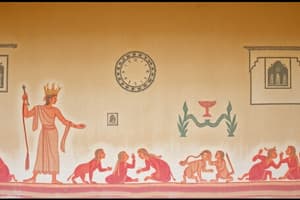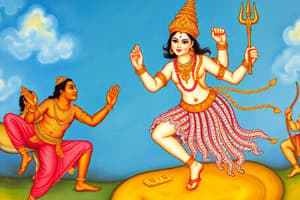Podcast
Questions and Answers
What does the stupa in Fig. 4.15 represent?
What does the stupa in Fig. 4.15 represent?
- The mahaparinibbana (correct)
- The renunciation of the Buddha
- The meditation of the Buddha
- The first sermon of the Buddha
The tree in Fig. 4.15 stands literally for a tree.
The tree in Fig. 4.15 stands literally for a tree.
False (B)
What is the name of the image depicted in Fig. 4.17?
What is the name of the image depicted in Fig. 4.17?
shalabhanjika
Historians need to familiarise themselves with the ______________________ of those who produced these works of art.
Historians need to familiarise themselves with the ______________________ of those who produced these works of art.
What is the significance of the wheel in Fig. 4.16?
What is the significance of the wheel in Fig. 4.16?
The sculptures at Sanchi were directly inspired by Buddhist ideas.
The sculptures at Sanchi were directly inspired by Buddhist ideas.
What is the event depicted in Fig. 4.15 (middle right)?
What is the event depicted in Fig. 4.15 (middle right)?
The woman at the gate in Fig. 4.17 is holding onto a ______________________.
The woman at the gate in Fig. 4.17 is holding onto a ______________________.
Match the following figures with their significance in Buddhist art:
Match the following figures with their significance in Buddhist art:
Flashcards are hidden until you start studying
Study Notes
Artistic Techniques
- The artists used the technique of shading to give a three-dimensional quality to their paintings.
Naturalistic Paintings
- Some of the paintings are extremely naturalistic.
Motif: Gajalakshmi
- A recurring motif is that of a woman surrounded by lotuses and elephants, which seem to be sprinkling water on her as if performing an abhisheka or consecration.
- This figure may be identified as Maya, the mother of the Buddha, or as Gajalakshmi, the goddess of good fortune associated with elephants.
- Devotees who saw these sculptures may have identified the figure with both Maya and Gajalakshmi.
Motif: Serpent
- The serpent is a motif found on several pillars, possibly derived from popular traditions not recorded in texts.
- James Fergusson, an early modern art historian, considered Sanchi to be a centre of tree and serpent worship.
Storytelling in Stone
- The sculpture in Figure 4.13 appears to depict a rural scene but is actually a scene from the Vessantara Jataka, a story about a generous prince who gave away everything to a Brahmana.
- Art historians study the sculpture by comparing it with textual evidence.
Symbols of Worship
- Early sculptors did not show the Buddha in human form but instead showed his presence through symbols.
- The empty seat symbolizes the meditation of the Buddha, and the stupa represents the mahaparinibbana.
- The wheel symbolizes the first sermon of the Buddha, delivered at Sarnath.
- These sculptures cannot be understood literally and require familiarity with the traditions of those who produced them.
Popular Traditions
- Sculptures at Sanchi were perhaps not directly inspired by Buddhist ideas, such as the image of a woman swinging from the edge of the gateway, holding onto a tree.
- This image may be a representation of a shalabhanjika, a figure described in Sanskrit literature.
Studying That Suits You
Use AI to generate personalized quizzes and flashcards to suit your learning preferences.




